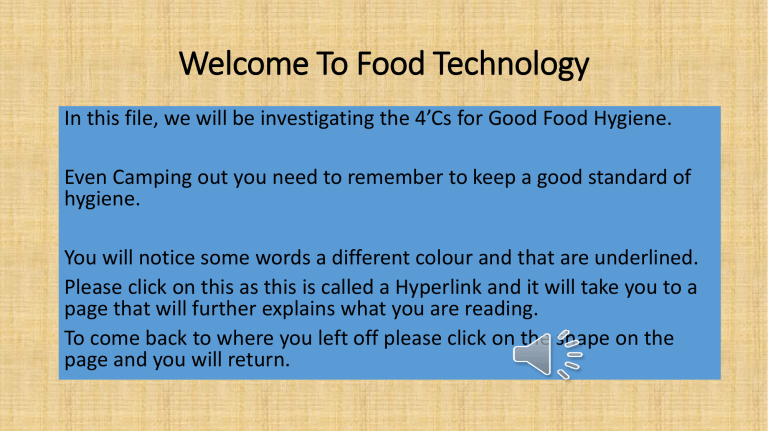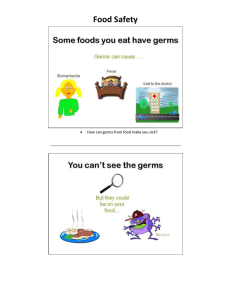
Welcome To Food Technology In this file, we will be investigating the 4’Cs for Good Food Hygiene. Even Camping out you need to remember to keep a good standard of hygiene. You will notice some words a different colour and that are underlined. Please click on this as this is called a Hyperlink and it will take you to a page that will further explains what you are reading. To come back to where you left off please click on the shape on the page and you will return. The 4 C’s for Good Food Hygiene Learning Goals: By the end of this lesson you will understand the ‘4C’s for Good Food Hygiene. Success Criteria: I will be able to name four good hygiene practices for: Chilling, Cleaning, Cooking and Crosscontamination. I will recognise the symptoms of food poisoning and how to avoid it. https://www.youtube.com/watch?v=nkVY08aqC28 From watching the video we can see that: What is Food Hygiene? • Food hygiene is the practice of properly chilling, cooking, cleaning food and avoiding cross-contamination to prevent the spread of bacteria in food. • Improper food hygiene when handling raw food may lead to food poisoning. • Food poisoning bacteria grow very quickly in food if it is not handled properly, cooked properly or stored properly. • How to know if you may have food poisoning. Here are the Symptoms: Wash and dry chopping boards, utensils and work surfaces after preparing raw meats and poultry. How to wash hands properly: Click here Wash hands for 20 seconds with warm soapy water and dry them before starting to cook. (singing Happy Birthday, is about the right amount of time to wash your hands) You should repeat : 1. After using the toilet 2. After blowing their nose, coughing or sneezing; 3. After petting animals. Have a look at the proper way to wash your hands. The following video, demonstrates the correct technique hand washing. https://www.youtube.com/watch?feature=player_detailpage&v=vYwypSLiaTU • Cook poultry, hamburger, minced and stuffed meats and sausages until juices run clear. • Defrost frozen poultry, minced, rolled and stuffed meats thoroughly before cooking. • Always follow cooking instructions on packaged foods. • Reheat foods to steaming hot all the way through before eating. • Cooked foods (including vegetables and rice) should never be reheated more than once. • Keep hot foods steaming hot at or above 60°C. Click here Food poisoning is often caused when harmful bacteria on one food are spread via hands or kitchen utensils to cross-contaminate other foods. Good hygiene helps prevent this. •Keep raw foods separate from cooked and ready-to-eat food at all times. In particular keep raw meat, fish, poultry and other raw foods away from ready-to-eat foods such as salads, bread and sandwiches. •Never put cooked food on a plate which has previously held raw foods until it has been thoroughly washed. •Ideally use separate chopping boards for raw and cooked foods. Click Here •Wash hands after handling raw foods and before touching other foods and utensils. Chilling • Keep your fridge at 5°C and your freezer at -15°C. • Keep cooked and perishable foods in the refrigerator. • Refrigerate hot foods as soon as they stop steaming. • Refrigerate leftovers promptly. • Defrost food in the fridge, not on the sink or bench. • Cook foods defrosted in a microwave immediately. Campylobacter can often be found in raw chicken and chicken that is not cooked thoroughly. You can’t see, smell or even taste it, but it can make you very sick with food poisoning. Following these tips can help you avoid it. Try our ‘Chicken Challenge’ to see if you can unscramble the words that match the picture and description. Ready, steady, go! The End Raw Meat Poultry Fish There are different types of Hygiene. Here is an example of Personal Hygiene Some bad habits to avoid. Click here Juices running clear Poultry still bloody Bacteria cannot be seen with the naked eye. If you could see the germs it would look something like this!


